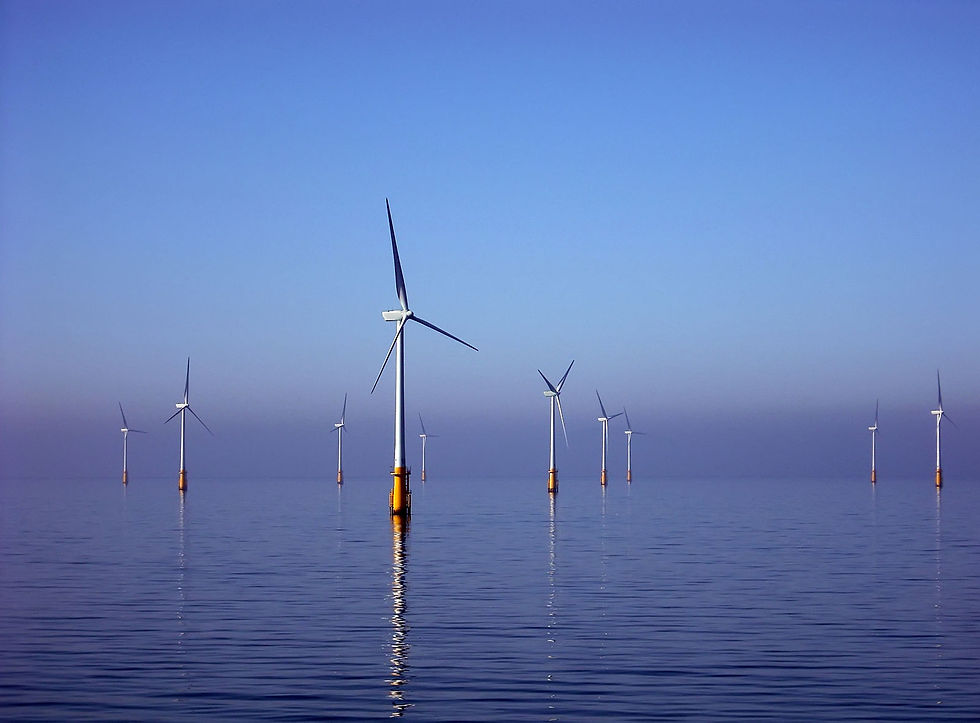Offshore Wind Company RWE Plans to Start Site Surveys This Summer
- Matt Simmons

- May 28, 2024
- 3 min read
Updated: May 29, 2024

Humboldt offshore wind is about to reach another milestone. RWE, one of the Humboldt Wind Energy Area’s two leaseholders, plans to begin conducting site characterization surveys this summer. A final environmental assessment for site characterization and surveys was issued by the Bureau of Ocean Energy Management (BOEM) in May 2022. This environmental assessment DOES NOT permit the offshore wind developers to construct or operate wind turbines, but merely allows them to conduct site assessment and research in order to facilitate future development and environmental review.
So what does site assessment for a massive offshore wind project entail? Well, the first thing the developers want to do is map the seafloor of their lease area, which begins 20 miles off the coast of Humboldt. Very little is currently known about the ocean floor within the lease area, which ranges in depth from 1,760 to 3,400 feet below sea level. Before project planning can even really begin, developers have to know what their wind turbines will be floating on top of. So how does RWE plan to gather information about the ocean floor?

With robots! RWE plans to utilize what is known as an autonomous underwater vehicle (AUV) to survey the ocean floor. The AUV will be brought out to sea on a boat and dropped in the water, and then it will dive down to approximately 130 feet above the seafloor. Once it is deep below sea level, the AUV will take incredibly high resolution images of the seafloor, creating a detailed map of benthic habitats, rock formations, and anything else lying in wait at the bottom of the ocean.


EPIC is particularly interested in seeing what sensitive habitats are located in the lease area, including hard substrate, rock outcroppings, seamounts, or deep-sea coral/sponge habitat. If particular items of interest are discovered, the AUV may dive even deeper (to about 20 feet above the seafloor) in order to take even more detailed photos. As the name suggests, the AUV is unmanned and autonomous. It navigates automatically and continuously, using instruments on board to avoid crashing into the seafloor or deepsea rock formations.
Traditional site assessment equipment involves towing large acoustic arrays behind a ship. Those acoustic arrays sit at the ocean’s surface and use powerful sonar to map the seafloor. A U.S. Geological Survey mission actually used Cal Poly Humboldt’s (formerly Humboldt State University) R.V. Coral Sea to map parts of the seafloor off the coast of Humboldt in 2019 using this traditional method. The maps produced are helpful, but not high resolution enough to confidently map sensitive habitats as needed for the wind farm to pass environmental review. From an environmental perspective, AUVs are definitely preferable to a traditional acoustic array. Since AUVs get so close to the seafloor, they’re able to use lower energy sources and focus like a flashlight beam on smaller portions of the seabed, disturbing the marine environment far less. In order to obtain the same resolution images from a traditional acoustic array, developers would have to emit so much energy that they would violate State regulations designed to protect marine life. By gathering as much information as possible using AUVs, the developers can avoid or minimize the use of acoustic arrays in the future.

Once offshore wind developers have their map of the seafloor, they can begin planning their project to best avoid environmental impacts. That will likely involve sediment sampling the seafloor and beginning to look for routes to lay the transmission cable that will bring power from the turbines to shore. These kinds of surveys are also an important step in the environmental review process of the project itself because they let the agencies know what needs to be protected under the ocean. To learn more about AUVs and offshore wind site surveys, listen to the most recent episode of the EcoNews Report, in which EPIC’s Executive Director Tom Wheeler interviewed representatives from RWE about their plans.





Comments